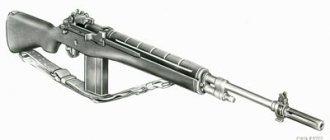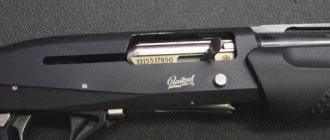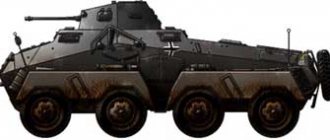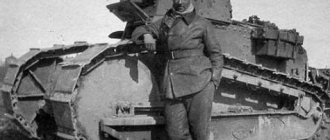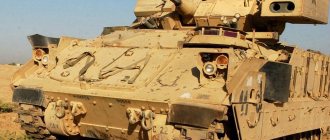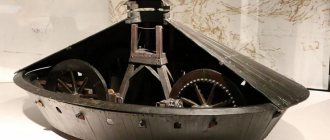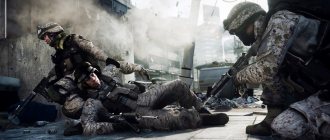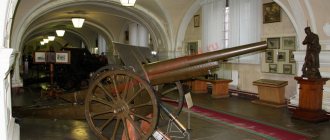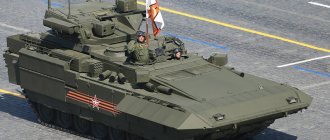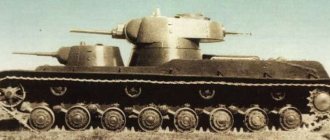Heavy armored vehicles. Reality and expectations. Part 1
Armored vehicles come in many shapes and sizes and perform many different tasks.
In a series of articles, two categories will be considered: armored combat vehicles that conduct only direct fire, and vehicles that also serve to deliver infantry to the battlefield. The term "armored vehicles" is quite broad. It can range from vehicles that simply have armor to protect the people inside, to complex combat systems that can be as complex as a fighter jet or a gunship. Currently, there are more and more parallels between combat systems used on land, on water and in the air.
This large number of different "armored" vehicles makes any discussion difficult. The very attempt to classify them is inherently quite difficult. The use of the terms "light", "medium" and "heavy" was once logical. This indicated the mass of the system, which in turn was closely related to the level of protection, since protection was mainly a direct consequence of the amount and thickness of armor. The more armor, the better the protection and the greater the weight of the vehicle.
A similar correlation also arose between mass and armament, since the mass of a heavier vehicle, as a rule, determined the installation of a larger caliber gun. Thus, lighter vehicles were most often armed with smaller caliber cannons, while heavier vehicles were often armed with larger, long-range cannons. However, advances in technology have blurred these distinctions and made the categories “light,” “medium,” and “heavy” largely meaningless.
Even the terminology used to describe the qualities of armored vehicles needs to change, as it must accurately reflect the specific characteristics and how they are obtained. For example, it would be more correct to consider “protection” within the concept of “survivability”. It provides an opportunity to better describe the set of factors that collectively contribute to crew safety and enable mission continuation. Our understanding of “mobility” has similarly changed. It was once believed that a tracked undercarriage was a prerequisite for mounting heavy weapons and provided the highest off-road capability, but at a speed limit. Today, however, main battle tanks (MBTs) weighing 70 tons can easily reach 70 km/h, while some wheeled combat systems have the same weapons as main battle tanks.
Dividing armored vehicles by task makes more sense and importance. However, even here differentiation can be complex, partly as a result of technological change. Larger caliber guns can now be installed on lighter vehicles, for example. In many cases, these new weapons can even be installed on existing vehicles as part of modernization programs. Likewise, advances in propulsion systems, including lighter, more compact powertrains and high-performance hydropneumatic suspension, allow for increased payload capacity without compromising mobility. As a result, this helps to increase the level of protection and power of weapons. Significant advances in sensor technologies, data processing, communications (including data transmission) and automation (including remote operation) also open up new opportunities for combat vehicle developers.
Improvement and modernization programs make it possible to increase the capabilities of existing vehicles at relatively modest costs, often increasing the flexibility of their combat use. This trend is aimed at reducing the differences between machines that could perform different tasks. There is growing recognition that deploying universal platforms (where appropriate) provides benefits in terms of service, logistics and life cycle costs. New solutions, design approaches, manufacturing methods and logistics technologies are combined to achieve “multi-task capability in a single platform.”
The article discusses those armored vehicles that are directly used in combat. These are the frontline vehicles that are the Schwerpunkt (German: main focus, essence, center of gravity) of tank warfare. The combat effectiveness of these systems remains based on the triad of key characteristics of traditional armored fighting vehicles (AFVs) - firepower, mobility and protection. Advances in situational awareness and command and control capabilities increasingly complement these traditional components of the AFV and contribute to the expansion and development of many armored vehicle capability enhancement programs.
In this article, combat vehicles are divided into two categories according to their main purpose. The first category includes armored fighting vehicles, whose main task is firing; thus, they can be considered as direct fire systems. This category includes main battle tanks, self-propelled anti-tank guns, and light tanks. self-propelled artillery mounts and other systems. All of these mobile platforms are optimized for precision direct fires, have trained crews, and have levels of protection tailored to a specific set of threats.
The second category includes combat platforms that are designed to deliver infantry to the battlefield, after which they dismount and fight (often under the cover of their vehicle). Often, such vehicles may have common features with platforms from the first group, but at the same time they can accommodate an infantry squad inside them.
The proportion of each component of the triad of key characteristics may vary, some vehicles have the same advanced fire control systems as the MBT, but a smaller caliber gun, while other platforms have weaker armor.
Including firing systems and infantry transport vehicles in one article makes sense. Both categories of vehicles often operate in the same battle formations. They are able to support and complement each other, contributing to success on the battlefield.
M1A2 Abrams
Developer: General Dynamics Land Systems Country of origin: United States of America Armament: 120 mm M256 smoothbore gun
The original M1 tank with a 105-mm M68 rifled gun with a 52-caliber barrel was put into service in 1980. A variant designated M1A2 was released in 1990. Like the previous version of the M1A1, it is armed with a 120-mm M256 smoothbore gun, developed by the German company Rheinmetall AG for the Leopard 2 tank; In addition, an improved fire control system (FCS) was integrated and other improvements were implemented. Option A2 has undergone a number of improvements, designated SEP (System Enhancement Package - system enhancement kits). The newest Abrams SEP kit is the M1A2 SEPV3, the first production vehicles in the V3 variant were delivered in October 2022. Funding problems have limited the deployment of new versions of the tank in the American armed forces, as a result, a large number of vehicles in the M1A2 variant remain in the army. This means that while there are Abrams variants capable of meeting the most advanced potential threats, these vehicles may not be available in the units that have a chance to face those threats. At the first demonstration of the new variant, the program manager for ground combat vehicles said that “The Abrams M1A2 SEPV3 is a major step forward in reliability, resilience, protection and on-board power, making Abrams and our armored brigades relevant for years to come. Even under financial constraints that prevent the creation of entirely new vehicles, the Abrams M1A2 SEPV3 demonstrates that we can still make significant and operationally desirable improvements.” The US Army has already initiated the development of the V4 configuration.
Leopard 2
Developer: Kraus-Maffei-Wegmann (KMW) Rheinmetall Country of origin: Germany Armament: 120 mm smoothbore Rheinmetall L/55
Leopard 2 is one of the most common MBTs in the world. Introduced into service in the 1980s, it has been continuously modernized and improved in response to the challenges of the battlefield through the introduction of new technologies and innovative solutions. The tank's widespread worldwide acceptance was driven not only by these key improvements, but also by the active promotion of modifications and upgrades that made it possible to "customize" its capabilities for different operators and geographic regions. In recent years, some customers have not missed the profitable opportunity to purchase Leopard tanks from the armies of NATO countries. Many options for modernizing the Leopard 2 tank have been developed and proposed, including not only by Rheinmetall, but also by the industry of the countries that customer these vehicles. The German Bundeswehr is fully equipped with Leopard 2A7V standard tanks. He also recently decided to launch the “Improving Combat Capabilities IV” (Kampfwertsleigerung IV, KWS IV) program. This will allow the German Army to upgrade part of its MBT fleet to the new Leopard 2A8 standard as an interim solution until the development of a new tank (Main Ground Combat System or Leopard 3) is completed. Variants of the Leopard 2 are in service in 18 countries, and about six more countries have expressed interest in purchasing new or surplus tanks from various sources.
Leсlerc
Developer: Nexter (formerly GIAT) Country of origin: France Armament: 120 mm smoothbore CN 120-26
The Leclerc tank, deployed in 1991, brought with it many innovative elements, for example, an on-board information and control system, which are now found in almost every combat vehicle. The 52-caliber main gun (44-caliber barrels were the standard at the time) provides a higher muzzle velocity and a flatter trajectory. It also has an automatic loader and an integrated fire control system that can hit six targets in 60 seconds with 95% accuracy. The coaxial machine gun has a caliber of 12.7 mm. This tank was the first among MBTs to be equipped with hydrodynamic suspension. Leсlerc is currently undergoing modernization, which includes the installation of a remotely controlled weapons module, additional hull and turret armor, new radio stations and SCORPION control system. The gun of this tank can fire programmable air burst ammunition. Leсlerc is also in service with the UAE army, which used it in combat operations in the Yemen conflict.
Challenger 2
Developer: Vickers Defense Systems (now BAE Systems) Country of origin: UK Armament: 120mm rifled L30A1
The British FV 4034 Challenger 2 MBT is the successor to the Challenger 1 and entered service in 1994. The tank is in service with Great Britain and Oman. In addition to the main 120 mm rifled gun, a coaxial 7.62 mm L94A1 (EX-34) chain-driven machine gun is installed; both of these systems are unique to NATO MBTs. The use of a rifled barrel for the main gun has no analogues among modern MBTs. It was chosen due to the British Army's emphasis on using armor-piercing high-explosive HESH (High-Explosive Squash Head) shells along with armor-piercing finned sabot shells. Another unique feature is that the main gun fires projectiles and propellant charges that are fed into the chamber separately. Protection is provided by second generation Chobham armor (known as Dorchester) with dynamic protection and lattice screens installed if necessary. The steel bottom is reinforced with armor as part of the "Streetfighter" modernization project.
The British Ministry of Defense is currently implementing the Life Extension Project. At the end of 2016, it awarded contracts to a group led by Rheinmetall Landsystems and a group led by BAE Systems to provide the solution for the evaluation phase. After a positive decision is made, the winner may be issued a contract for serial production. Offerings include new thermal imaging and commander's sights, an upgraded fire control system, new displays, open architecture systems, threat warning and situational awareness systems. The Ministry of Defense has awarded a contract to QinetiQ to evaluate active protection systems for the Challenger tank as part of its MEDUSA project.
T-90S
Developer: Uralvagonzavod Country of origin: Russia Armament: 125 mm smoothbore 2A46M
The T-90 tank is in service with the Russian army; its export modification T-90S is also widely present in the armies of other countries, including Syria and India. For example, Indian T-90 Bhishma tanks are manufactured under license at a plant in Tamil Nadu. The T-90 (original designation T-72BU) is a further development of the T-72B and T-80U models, which have received significant upgrades and improvements. The 125 mm cannon, stabilized along two axes, fires traditional projectiles and guided missiles. Shots are fired from a carousel-type automatic loader. The missile with a range of 4000-5000 meters has a laser beam guidance system and a cumulative warhead. The fire control system and day/night sights allow you to effectively acquire targets and identify them at a distance of up to 1500 meters, even in conditions of limited visibility. Protection is provided through a combination of traditional armor and dynamic protection units, as well as the Shtora-1/1M optical-electronic suppression complex. The complex includes an infrared jammer, laser warning sensors and smoke screen grenade launchers.
T-14 Armata
Developer: Uralvagonzavod Country of origin: Russia Armament: 125 mm smoothbore 2A82-1M
The T-14 tank of the Armata project caused a stir in the West after its first display in 2015. It includes a number of innovative elements, including a universal tracked platform, an uninhabited turret, an armored crew capsule, and is equipped with an improved main gun and additional defensive subsystems. The gun can fire newly developed ammunition and guided missiles. For example, the Vacuum-1 armor-piercing sub-caliber projectile has a depleted uranium core 900 mm long, which can penetrate 1000 mm of rolled homogeneous armor from a distance of 2000 meters. The 2A82-1M main gun can also fire a fragmentation-shrapnel projectile with remote detonation on the Telnik trajectory; in addition, it is compatible with the 9M119M1 Invar-M guided missile of the Reflex-M complex, which has a range of 5000 meters. The crew's protection is enhanced by placing it in the center of the hull, as well as the Afganit active protection complex (APS), one of the components of which is a millimeter-wave radar for detecting and tracking targets. The T-14 tank includes a radar with an active phased array antenna, multispectral sights for the commander and gunner, networked sensors, and an automatic target detection system. The tank's developer claims that its thermal imaging sights can detect a target at a distance of 5,000 meters, although it is worth noting that previous thermal imaging sights were of French origin.
The further fate of the T-14 tank, judging by reports from officials and other sources, is quite uncertain and it is very likely that the number of production vehicles will be reduced. However, this project uses a number of concepts that have been implemented on other armored fighting vehicles.
T-84 Oplot
Developer: Kharkov Mechanical Engineering Design Bureau named after. A.A. Morozova Country of origin: Ukraine Armament: 125 mm smoothbore KBA-3
The Oplot tank is the fruit of a huge amount of work done by specialists from the Kharkov enterprise to improve the T-80 MBT. The first to appear was the T-84U variant, which added side screens, Kontakt-S dynamic protection on the turret, an auxiliary power unit, thermal imaging sights, a commander's laser rangefinder, a system for aligning the gun axis with the optical axis of the sight, as well as a navigation system. Later followed by the T-84 Oplot, and more recently the T-84M or BM. This version is equipped with a completely new welded turret (retaining the 125 mm cannon) with an automatic loader in the rear niche of the turret (instead of the carousel type), an isolated ammunition rack is organized and an updated fire control system is installed, including a search-and-strike mode. Passive and active armor and an electronic countermeasures subsystem are also installed. The main emphasis was placed on concluding export contracts, for which a number of presentations were held, which were not very successful. As part of the contract concluded with Thailand, there were constant delays in the delivery of tanks, although it was recently completed.
Merkava
Developer: MANTAK Country of origin: Israel Armament: 120 mm smoothbore MC253 (M68)
The Merkava tank (Hebrew, chariot), developed to meet the needs of the Israeli armed forces, entered service in 1978. The engine installed in front allows the rear compartment to be used for transporting ammunition, troops or wounded. The latest Merkava IV variant includes a host of new technologies, including an upgraded Knight Mark 4 electro-optical fire control system with automatic target tracking and improved thermal imaging capabilities, as well as enhanced anti-helicopter capabilities. A number of measures were implemented on the tank to reduce the heat signature. The Merkava IV tank also features locally developed composite armor with additional modular protection. In addition to the coaxial 7.62 mm machine guns mounted on the roof, the tank is also armed with a 12.7 mm machine gun mounted on the main gun mantlet; in addition, the tank’s armament complex includes a light 60 mm mortar for setting up a smoke screen. The Merkava Mk4M is equipped with an Israeli-developed KAZ Trophy with a laser and radar warning system, which is capable of intercepting any approaching projectile/missile and indicating the position from which the shot was allegedly fired. The Tzayad BIUS can transmit this information to other vehicles in order to perform an evasive maneuver or fire at a target.
K-2 Black Panther
Developer: Hyundai Rotem Country of origin: Republic of Korea Armament: 120 mm smoothbore Rheinmetall L/55
The K-2 Black Panther tank was developed in South Korea, its design is optimized for operations in the mountainous terrain of that country. The tank entered service in a limited batch in 2014, and these tanks were equipped with a locally produced engine. Officially, the K2 entered service in 2016, only now the tanks were equipped with a power unit consisting of a license-produced MTU 883 engine and a RENK transmission. There were plans to produce a second batch of K-2 tanks with a 1,500 hp power unit. Doosan and an automatic transmission from the local company S&T Dynamics, but it turned out that the transmission did not meet the required reliability standards, which delayed further production until 2022. The tanks of the second batch will have a “hybrid” power unit consisting of a local engine and a German RENK transmission. The K-2 tank also includes a number of unique elements, including extended-range KSTAM ammunition fired from the main gun (the 55-caliber 120-mm gun is based on the Rheinmetall L55 gun), a hydropneumatic suspension that allows the tank to “squat” when fire control, a millimeter radar connected to a fire control system, and special multi-layer composite and reactive armor. What local businesses could not develop was manufactured under license or reverse engineered. Korea is eager to export its defense systems and, as a result, has signed a cooperation agreement with Otokar to use K-2 tank technology in the development of the Turkish Altay MBT.
To be continued…
Infantry weapons for trenches and attacks
Degtyarev infantry machine gun
The Second World War was a period of massive use of a large number of new weapons. This also applies to small arms. And in many ways, the solutions of Soviet designers were advanced for their time. The development of new weapons in the USSR in the interwar period and during the Great Patriotic War is associated with the names of such famous designers as Fedor Tokarev, Sergei Simonov, Georgy Shpagin, Vasily Degtyarev and others.
During World War I, soldiers' primary weapons were long-range, high-powered rifles, like the Russian Model 1891 Mosin rifle. Good for trench warfare, for which range and accuracy were important, such weapons were not very convenient in close combat and in firefights at a distance of up to 100 meters. The main disadvantage is the low rate of fire. Therefore, very often, during an attack, soldiers of the First World War switched to hostility, without even wasting time on a firefight.
In the 20-30s, designers and military personnel had several options for further development of weapons. One of them is the creation of a rapid-fire automatic rifle. The first examples of Russian self-loading rifles appeared even before the revolution. So, in 1911-1916, such weapons were developed by the famous designer Vladimir Fedorov. Tokarev, known for the legendary TT pistol (Tula Tokarev), back in 1910 and in 1912, presented the tsarist army with samples of automatic rifles, one of which was a converted Mosin rifle. However, competitions for launching into mass production began only in the USSR only in 1928.
Simonov and Tokarev rifle
The first mass-produced self-loading rifle put into production in the USSR was the ABC-36 (Simonov automatic rifle of 7.62 mm caliber). Initially created as a self-loading rifle, the rifle was subsequently modified and received an automatic firing function. It was assumed that soldiers would shoot from it like a machine gun in extreme cases, for example, during a surprise attack by the enemy. Due to the powerful recoil, it was impossible to conduct automatic fire from the hands with the ABC; it was assumed that the soldiers would shoot from a prone position. Therefore, the key to switch the rifle to automatic mode had to be kept by the commander, and it was planned to hand it over to the soldiers only as a last resort.
As a result, only about 36 thousand copies of ABC were produced. The weapon was abandoned because the command demanded the creation of a self-loading rifle that would not have the function of a machine gun (that is, it could only fire single shots), and, therefore, the soldiers would not waste ammunition. Designer Fedor Tokarev won the competition. The rifle he presented later became the SVT-38, and after modification - the SVT-40. By 1941, more than a million of these rifles had been produced, and in some units it was the main weapon.
SVT-40
However, during the retreats at the beginning of the war, most of the rifles were lost. As for the German troops, they highly appreciated the SVT-40; The Wehrmacht actively used these captured rifles. At the same time, the Germans were very surprised that the Russians had a large number of automatic weapons, primarily self-loading rifles.
At the same time, the rifle gained a reputation among Soviet soldiers as unreliable. In addition, the rifle turned out to be very expensive to manufacture. As a result, the production of SVT was greatly reduced, and the USSR finally abandoned the idea of an automatic rifle for the duration of the war, focusing on the production of cheap and reliable Mosin rifles.
Melee Weapons
Soviet troops compensated for the low rate of fire of rifles with a large number of submachine guns. Despite the name, the weapon had nothing in common with either long-range heavy machine guns or pistols - weapons of self-defense. The high rate of fire made submachine guns excellent melee weapons.
Shpagin submachine gun
The most famous Soviet submachine gun, the legendary PPSh, created by designer Georgy Shpagin, became a symbol of victory and was immortalized in many monuments, photographs and paintings. Shpagin's submachine gun was ahead of many of its contemporaries (including the MP-38/40 assault rifle, known as the "Schmeisser") in range, reliability and firepower. The PPSh became the most popular submachine gun of World War II: about six million were produced. Even in Germany they tried to produce PPSh chambered for Parabellum cartridges, but only 10 thousand were produced.
However, the PPSh was not the only Soviet submachine gun. So, back in 1927, Tokarev created a submachine gun. It was interesting because most of it was made of wood, including a store built into the wood. This made the submachine gun convenient to shoot. During the Finnish War of 1939-1940 and at the beginning of the Great Patriotic War, the troops also actively used the Degtyarev submachine gun (PPD), which was similar in characteristics to the PPSh. However, the latter was more technologically advanced and easier to produce, so the final choice was made in its favor.
Heavy weapons
However, the most effective infantry weapon during the Great Patriotic War remained the machine gun. During World War I, the Army's main machine gun was the Maxim machine gun. During the interwar period, Soviet designers refined the already proven design. So, in 1924, Fyodor Tokarev created a modification of the Maxim machine gun. It was lighter in weight while maintaining firepower.
At the same time, the main task for the designers was to create a universal machine gun that could fire both from the machine and from the bipod; with such a machine gun it would be convenient to attack and stand on the defensive. Maxim's machine gun was not suitable for this - the weapon was too heavy. The Degtyarev infantry machine gun became such a universal weapon. Weighing 8.5 kilograms with a bipod, the machine gun could fire effectively at 800 meters (and the bullet could hit a target up to 3.5 kilometers).
Degtyarev infantry machine gun
The machine gun became the most popular in the Soviet army - more than 800 thousand units of this weapon were produced. Degtyarev also developed modifications of this machine gun for tanks and aircraft. It is noteworthy that Degtyarev and Shpagin developed a heavy machine gun, which was put into service
During the Great Patriotic War, small arms designers had to solve unusual problems. One of these tasks was to compensate for the tank superiority that German troops achieved as a result of the first weeks of the war. One of the solutions was the legendary anti-tank rifle. Until 1941, the USSR already had the Rukavishnikov anti-tank rifle in service, which allowed automatic firing. However, it turned out to be ineffective due to its weak firepower: in fact, the PTR hit only weakly armored targets.
PTRD
Therefore, Degtyarev and Simonov were tasked with developing new anti-tank rifles. Both designers completed the task in 22 days. Both weapons became widespread: more than 280 thousand units of PTRD and more than 190 thousand units of PTRS were produced during the war. The guns had similar characteristics in terms of fire power, but the PTRS was self-loading. Simonov's gun made it possible to fire five more shots per minute, but was three kilograms heavier (20 kilograms versus 17) and more difficult to manufacture. It is noteworthy that anti-tank rifles were used not only to fire at tanks, but also to destroy aircraft.
However, post-war design thought made some World War II developments irrelevant. Thus, anti-tank guns replaced hand grenade launchers and anti-tank missiles, and the guns themselves were no longer able to penetrate the thick armor of tanks.
Simonov self-loading carbine
In this sense, the example of the Simonov automatic carbine is indicative. By the end of the war, Sergei Simonov developed a self-loading carbine (SKS), which was superior in its characteristics to many rifles of its time. However, the idea of self-loading rifles as mass-produced weapons was already a thing of the past: in their place were machine guns, called “assault rifles” in the West. As a result, the SKS was in service for about 10 years, but finally lost ground to the Kalashnikov assault rifle. True, now this weapon is often used in honor guards because of its beauty.
How has the army changed from the king to the present day?
Happy holiday, all soldiers and sailors who have served and are currently serving, sergeants and foremen, warrant officers and midshipmen, officers, generals, admirals and marshals! Hurray!
Photo: Yulia PYKHALOVA
Today we decided to look at the history of the army from the time of Nicholas II to Putin through the prism of statistics (see table) - from the number of armed forces to the salary of an officer and an ordinary soldier under different rulers of the country.
Each number is a reflection of the time in which the army lived or is living. A lot is “pressed” into each figure: the international and domestic political situation, the economic resources of the state and the capabilities of its defense industry, the level of military-technical development and the size of the state treasury.
The army in Russia a century ago and now are incomparable things. But the spirit of the Russian soldier - defender and winner - is always the same.
BAYONETS AND TIME
The number of bayonets under the battle flags of the army, be it 1914, 1920, 1939, 2019 or any other year, was determined, as already mentioned, primarily by the military-political situation. During the Cold War, the number of personnel in our army sometimes exceeded 5 million people. After the fall of the USSR, the Russian army became one million strong. And today it ranks fifth in the world in terms of the number of military personnel after China (2.2 million), the USA (1.4 million), India (1.3 million), and North Korea (1.2 million).
THICKNESS OF ARMOR FIST
In the First World War, our army had only... two tanks. In the Civil War there were already a dozen and a half (all foreign), and then the country began to establish domestic tank production and rose to the forefront in the world. So much so that it became the champion of the planet in terms of the number of tanks - 63 thousand combat vehicles (according to other sources, 69 thousand). After the collapse of the USSR, the Russian army received a third of the Soviet tank arsenal - 22 thousand. Today we have approximately 12 thousand units of “armor”, of which 2 thousand are in combat formation, the rest are at storage bases.
COMBAT WINGS OF THE MOTHERLAND
In 1914, and even in 1920, the word “airplane” often appeared in the documents of the headquarters of the Tsarist and then the Workers’ and Peasants’ Red Army. We weren’t used to airplanes back then. The Great Patriotic Country met with 7 thousand combat aircraft. During Brezhnev’s time there were 3,500 of them. After the fall of the USSR, almost 1,000 vehicles went to the armies of the national republics. And after 1991, there were years when our Air Force received... only one aircraft per year. And only after 2010 the situation began to change noticeably. Now the rate of entry of winged aircraft into the army is such that military universities “do not have time” to train pilots for them and are forced to shorten their training period. Today Russia has a fleet of combat vehicles that are not inferior to the best foreign models.
WHO IS THE STRONGEST IN THE SEA?
Under Nicholas II, the Russian imperial navy was quite strong. But due to the huge loss of warships (sunk, captured by the enemy, interned by the Entente, or completely lost combat capability), their total number by 1917 had decreased significantly. In 1921, compared to 1917, only 5.5% of battleships, 0% of cruisers, 10% of destroyers, 5.8% of submarines, 2.7% of minelayers and net-layers, 4.9 % gunboats. And only by the second half of the 30s was the situation noticeably improved (by the beginning of the Great Patriotic War, the fleet had pumped up its muscles and was able to adequately withstand enemy forces significantly superior to it). After the war, our Navy became one of the strongest in the world. Today, gray-haired Mareman veterans sadly recall that golden time when, under the Commander-in-Chief of the Navy, Fleet Admiral Gorshkov, we were a powerful force on the seas and oceans. After the collapse of the USSR, our naval muscles became about 5 times weaker. We have almost completely abandoned aircraft carriers (we now have 1, and the USA has 12!). Some even began to sell “on pins and needles” abroad. In terms of the number of surface and submarine ships, we have left the first positions. It was only in recent years that the situation began to change noticeably. The Russian Navy regularly receives ships of all classes - from corvettes to nuclear-powered strategic missile cruisers.
Today, the Russian army no longer operates with tank armadas and fronts across half the continent, but with the jewelry work of special forces and aviation groups, as in Syria.
Photo: Alexander KOTS
NUCLEAR BOMB RACE
By creating the atomic bomb in 1945, the United States gained a colossal advantage over all the armies of the world. Let us thank our intelligence, which managed to obtain the main American secret. Who knows, if we had not already created our atomic bomb, Moscow and Leningrad could have faced the fate of Hiroshima and Nagasaki...
And then the nuclear arms race began, the USA and the USSR had such arsenals of the most formidable weapons that could destroy all life on earth 10 times over. This race was significantly slowed down by the treaties on the reduction of strategic offensive arms (START-3 is still in force). But significant mutual claims by the United States against Russia and vice versa led to the suspension of the Intermediate-Range Nuclear Forces Treaty, which destroys the established nuclear security system.
WHAT IS A COW FOR A COLONEL?
The monetary allowance of officers and soldiers has always been a certain measure of the state’s respect for its defenders, but it is quite difficult to compare the purchasing power of the ruble at different times. Therefore, we have to translate the numbers into natural products. The tsarist government kept the officer corps under its thumb, providing them with a comfortable life. Well, something went to the privates. So, a colonel under Nicholas II received 325 rubles. And what could he buy for that kind of money? Let's look at the documents of that time. Under Nicholas II, a cow cost from 8 to 10 rubles, and the daily earnings of a roofer averaged 2 rubles 8 kopecks, a carpenter - 1 ruble 92 kopecks, a mechanic and a blacksmith - 1 ruble 90 kopecks each. The soldier received 50 kopecks. He could buy a kilogram of bread for 5 kopecks, meat for 30 kopecks, sturgeon for 8 kopecks, a bucket of selected tomatoes cost 8 kopecks, and for a penny he was given a pocketful of seeds.
In Soviet times, the authorities tried not to offend the officer corps and, based on the size of their pay, kept them on a decent financial ration - a colonel received more than the director of a medium-sized plant, a lieutenant received more than an engineer. Well, the rank and file were paid enough to buy soap and toothpaste. After the collapse of the USSR, there were periods when the military were not paid for six months and their wives cooked quinoa soup. And even when the situation began to improve by the end of the 90s, the division commander, who had 7 thousand people and hundreds of pieces of military equipment under his command, received less than a supermarket cleaner (who only had a mop and a floor rag under her command). And only in 2012, the state was able to significantly improve the material support of officers and soldiers - the pay for officers was increased by almost 2.5 times, and for privates - by 4. Today, the officer corps of the Russian army, in terms of its size, is on the second floor of the social ladder (having passed ahead of the gas , oil moneybags and mediocre bank managers).
AUTHORITY AND THE ARMY: CHRONICLES OF RELATIONS
NICHOLAS II
The main small arms of the Russian Imperial Army was the Mosin rifle of the 1891 model - the famous three-line rifle. Photo: wikimedia.org
In the tragic year for Russia, 1917, the emperor failed to objectively assess the army’s attitude towards its political fate and paid for it. Almost all army generals and naval admirals, sensing the people's desire for a new way of life, turned away from the monarch and ceased to be his allies. Some went under the banners of the Red Army, while others went under the White Army. The tragedy of the Civil War was also that former fellow soldiers often stood against each other.
LENIN
Command of the First Cavalry Army of the Red Army (in the center - Army Commander Semyon Budyonny).
Photo: RIA Novosti
The leader of the revolution well understood the importance of the army for the new regime: “A revolution is only worth something if it knows how to defend itself.” And therefore he called on his defenders to “learn military affairs in a real way.” Lenin, with the help of his supporters (Trotsky’s role is great here), managed to create a new type of army - a workers’ and peasants’ army, which became the main support of the Bolsheviks.
STALIN
Under Stalin, the first mechanized corps began to be created and the infantry switched to equipment. In the photo: parade on Red Square on November 7, 1939. Photo: Anatoly GARANIN/RIA Novosti
Who knows what the beginning of the Patriotic War would have been like for the USSR if, following the denunciations of its own fellow citizens, the authorities had not mowed down the best representatives of the command staff during the years of repression. And yet, Stalin managed to preserve the great class of Soviet commanders, which, under his leadership, achieved the Great Victory in 1945. The Red Army has ceased to be ashamed of Russian military history: shoulder straps and insignia have returned to their uniforms, and orders and medals in honor of Russian commanders have appeared among military awards.
KHRUSHCHEV
In the 50s, the Soviet army almost completely switched to automatic small arms. Photo: Yuri SOMOV/RIA Novosti
Nikita Sergeevich sometimes behaved like a military-political adventurer in relation to the army. The size of the Armed Forces sometimes changed depending on his personal whims. Khrushchev in one fell swoop “castrated” the army for 1 million 300 thousand souls at once. Under him, the Bickford cord of nuclear war with the United States began to smolder during the Cuban Missile Crisis of 1962. Washington was so afraid that he was forced to compromise.
BREZHNEV
In 1968, the armed forces of the member countries of the Warsaw Pact Organization (except Romania) entered Czechoslovakia. In the photo: a Soviet soldier and a soldier of the Polish Army near Prague. Photo: Yuri SOMOV/RIA Novosti
The army remembers the times of Leonid Ilyich in different ways. And the unprecedentedly respectful attitude of the authorities towards people in uniform (and the trust of the people in the army reached 86%!), and the “mistaken” war in Afghanistan, where they were thrown by elderly members of the Politburo of the CPSU Central Committee. Under Brezhnev, our military was engaged in “pacifying” the rebellious Czechoslovakia and secretly participated in “foreign” wars in Angola, Egypt, Vietnam and other countries.
GORBACHEV
Soviet soldiers in Afghanistan with a Stinger just captured from the Mujahideen. Photo: Victor KHABAROV/ZERKALO
Mikhail Sergeevich had a bad relationship with the military. Both in the Ministry of Defense and in the troops there was opposition to the General Secretary of the CPSU Central Committee (and then to the President of the USSR). Wanting to please the West, Gorbachev more than once made serious concessions to it regarding the mutual reduction of missiles. Under him, our troops were withdrawn from Afghanistan and “fled” from Europe. Under Gorbachev, opponents of communist power stubbornly attacked its main support - the army. And the authorities were unable to protect her from the attacks of those who played the army card in the political struggle. The army's authority declined sharply. It is no coincidence that many military personnel supported the State Emergency Committee during the August 1991 coup.
YELTSIN
The new Russian army remained for quite a long time with the weapons that it received from the Soviet army. In the photo: a grenade launcher with an AGS-17 “Plamya” mounted grenade launcher in Chechnya, October 27, 1999. Photo: Alexey BELYANCHEV/ZERKALO
Boris Nikolaevich managed to lure part of the generals to his side, giving him key positions (Shaposhnikov, Grachev, Kobets, etc.). Under Yeltsin, the new Russian army (created in May 1992) achieved a shameful “victory” over the shot parliament (October 1993). The army was drawn into the first Chechen war. In order to win the 1996 presidential elections, Yeltsin even went to the lengths of deceiving voters, promising them to abolish conscription for military service.
PUTIN
In the last decade, the Russian army has acquired new weapons and equipment, and a completely different, very modern look.
Photo: GLOBAL LOOK PRESS
Under his leadership, a real and effective reform of the Armed Forces took place. The personnel changed qualitatively, the core of which began to be represented by professionals: under Putin, for the first time in the history of the new Russian army, the number of contract soldiers and sergeants began to exceed the number of conscript soldiers. The level of new and modernized military equipment is growing dynamically and has already reached an average of 65%. A whole galaxy of unique weapons that have no analogues in the world have been developed and put into service. The “security operation” in Crimea was carried out brilliantly. People's trust in the army increased to 92%.
Komsomolskaya Pravda recommends the unique album “Stalin. Main documents." 456 pages, more than 1000 declassified documents. The book can be purchased at shop.kp.ru at the address: Moscow, Stary Petrovsko-Razumovsky proezd, 1/23 building 1
Unique album “Stalin. Main documents."
18+ JSC Publishing House Komsomolskaya Pravda, Moscow OGRN 1027739295781
Tank transporters, tow trucks and tractors: little-known Lend-Lease heavy trucks
During World War II, no more than a dozen American companies and one British company were engaged in the production of special military vehicles and their deliveries under Lend-Lease to allied countries, including the USSR. Thanks to their developments, the troops received super-heavy trucks, all-wheel drive trucks and single off-road tractors, as well as repair and recovery vehicles, which had not previously existed in any country in the world. From this abundance we will select cars that came to the Soviet Union.
Five-ton semi-bonnet tractor unit Autocar U7144T with a characteristic flat radiator grille. 1941
Army off-road twins Autocar
Since the beginning of the 20th century) it has been producing conventional trucks and only in 1941 did it seriously engage in military equipment. The scope of its activity was all-wheel drive semi-hooded vehicles with rear gable wheels, which were used for towing semi-trailers and fuel tanks. U7144T truck tractors were the first to appear in Lend-Lease deliveries
with a 112-horsepower gasoline engine and angular shapes of a short hood.
Autocar U8144T tractors with an open cab and a machine gun transport pontoons to cross the Rhine. 1945
U8144T unified with them
used for towing special semi-trailers with engineering equipment, pontoons and metal sections of prefabricated bridges. Its features were a standard winch and a spacious box between the cabin and the fifth wheel, which contained tools and accessories. The Red Army received 42 U7144T and U8144T vehicles.
Bulldogs from the Hood: Mack Heavy Military Vehicles
From the first years of its existence, ) was one of the most important suppliers of military vehicles, which since the First World War, due to the iron-shaped front end, squat posture and widely spaced wheels, received the nickname “Bulldog”, which was personified by the figures on the hood.
Mack NR14 multi-purpose paramilitary trucks awaiting shipment to the Eastern Front
In 1941, on the failed three-axle Mack EX-BX chassis for an 18 thousand liter tank truck and a tank carrier, the first Mack militarized truck of the 10-ton army NR
(6x4). Until the end of the war, 16.5 thousand vehicles of this range were built in 20 versions - from NR1 to NR20. These were the most powerful airborne vehicles for transporting large military formations along public roads, transporting military cargo and towing guns weighing up to 15 tons.
Structurally, they were all unified with each other and differed in the types of cabins and bodies. They were equipped with their own in-line six-cylinder 8.5-liter ED diesel engine with 123 and 131 hp. with direct fuel injection. The transmission included a single-plate clutch, a ten-speed gearbox with two reverse gears and double final drives.
A 123-horsepower Mack NR6 artillery tractor with a closed cabin tows a 240-mm howitzer. 1942
At the end of 1942, Lend-Lease deliveries of Macs to the USSR began with the transition to a new long-wheelbase truck NR9
with a five-meter wheelbase. Its features were an open cabin, tented wood-metal bodies with extendable lattice sides and longitudinal folding benches, as well as all single wheels with tires of different sizes (front and rear - 24 and 20 inches, respectively).
A typical 131-horsepower Mack NR9 soft-top tractor for towing 15-ton guns. 1943
Standardized single-wheel truck NR9 with an open cab and a military body with a tarpaulin.
1943 In 1943, the next batches included simplified NR14
and
NR15
with the mechanical part and cab of the NR9 model, as well as with a wheelbase shortened to 4.4 meters and rear gable wheels. They differed from each other in the variants of cabins and wood-metal cargo platforms.
Mack NR14 tractor-trailer truck with a commercial cab and rear dual-slope wheels.
1943 At the height of the war, Mack began producing 7.5-ton NO
(6x6) for towing heavy artillery systems and transporting combat crew, ammunition and two spare parts in a shortened flatbed body with longitudinal seats. The vehicles were equipped with a 157-horsepower gasoline engine, a five-speed gearbox, an extended and expanded open cabin with a machine-gun turret and a front 18-ton winch.
Short-wheelbase artillery tractor Mack NO6 or Super Mack for towing heavy guns
Mack NO6 with an open cockpit with a machine gun emplacement and a body for 10 combat crew.
1944 The Red Army and Soviet transport organizations received 921 Mack NR trucks plus 14 NO6 tractors.
Still surviving Mack NR/NO heavy military vehicles
Mack NR14 heavy army truck nicknamed Meine Liebe Frau
Mack NO6 heavy tractor with 155 mm Long Tom two-axle howitzer
"Diamonds" in war: Diamond T army vehicles
The strange brand of famous American trucks, Diamond T, consisted of the popular name “Diamond” and the first letter of the surname of entrepreneur Charles Tilt.
During the war, this company produced four-ton army trucks of the T-967/968 series, but they were not included in Lend-Lease deliveries to the USSR. The exception was 20 T-972
(6x6) with three-cube bodies, built on a 106-horsepower T-968 cargo chassis.
Diamond T-972 Army Corps of Engineers dump truck with rear tip steel body.
1944 Since 1940, the military program of the Diamond T company included 12-ton ballast tractors of the M20 series (6x4), towing low-loading multi-wheel trailers with a carrying capacity of up to 52 tons, on which medium and heavy tanks along with their crews were quickly transported along paved roads and ammunition.
The Diamond T-980 ballast tractor tows a 40-ton 24-wheel Dyson trailer with a Churchill tank. 1945
Basic tractor T-980
was equipped with a six-cylinder Hercules diesel engine (13.4 l, 185 hp), a four-speed manual gearbox with a three-stage gearbox and a centrally located winch with a cable output to the rear or in both directions.
Tank transporter Diamond T-981 with a soft cabin top and a front winch cable outlet. 1943
Heavy tractor Diamond T-981 with a closed cabin and a ballast body with seats for combat crews.
An upgraded version of the T-981
differed in the additional output of the winch cable forward - through a hole in the left side of the bumper with guide rollers.
A Diamond T-981 tractor delivers a damaged Sherman tank on a 45-ton Rogers M9 trailer.
1944 Both vehicles had three-seater all-metal cabins with a sunroof or open ones with space for a machine gun, as well as steel box bodies for transporting ballast and combat crews. As part of road trains, their speed did not exceed 26 km/h.
Still surviving Diamond T-980/981 ballast tractors
Diamond T-980 tractor with three-axle 12-wheel M9 Rogers trailer
Diamond T-981 heavy tractor at the Allied landing site in 1944
Until the end of the war, the Diamond T company assembled 6.5 thousand T-980/981 series tractors, of which 471 vehicles and 531 standardized three-axle M9 trailers entered the Red Army.
A Daimond T-980 tractor with a Rogers tank trailer on display for Red Army officers. 1945
Heavy tank KV on a trailer with a Diamond T-980 tractor - a prototype of the Soviet version of the YaAZ-210G
Federal and REO: Lend-Lease truck tractors
Before the start of the Great Patriotic War, the Red Army did not use truck tractors with heavy semi-trailers, so Lend-Lease deliveries paid special attention to this fairly simple technique.
Since 1942, a relatively small but prestigious company has produced a multi-purpose military truck tractor model 604
(6x4) with a six-cylinder Cummins diesel engine of 130 horsepower and front air shock absorbers. It was used as part of road trains with a gross weight of up to 42 tons and towed 20-ton flatbed semi-trailers or low-bed trailers for transporting tracked vehicles and fuel tanks. Until 1944, Federal assembled one and a half thousand model 604 tractors.
Federal-604 truck tractor with M22 light tank on a 20-ton single-axle Trailmobile semi-trailer.
1943 At the same time) she collected complete copies of Federal 604 cars, bearing the index 28ХS
. Externally, they differed only in the shape of the air slots on the sides of the engine compartment. A total of 234 tractor units from both manufacturers and 198 semi-trailers for them were sent to the Soviet Union.
Heavy tractor REO 28XS with a two-axle airfield tank for 16 thousand liters of fuel.
1943 At the final stage of the war, identical multi-purpose 7.5-ton army chassis Federal 606
and REO
29XS
(6x6) with a 180-horsepower Hercules gasoline engine, which were combinations of recovery vehicles and truck tractors with 18-meter semi-trailers. They were assembled in 700 units, of which 14 were shipped to the USSR.
Federal-606 chassis with a 10-ton crane and a fifth-wheel 20-ton recovery semi-trailer. 1944
Military special equipment: what is SEM?
Since 1943, the Red Army received American repair and recovery vehicles (REVs), created on the basis of truck tractors and trucks with a 6x6 wheel arrangement. Their purpose was to provide roadside assistance, repair armored vehicles in the field, and evacuate damaged vehicles. All of them were equipped with towing and lifting vehicles, mechanical cranes, electric generators and welding equipment.
The beginning of a long journey: Kenworth military tow trucks
Today ) is one of the most reputable manufacturers of heavy commercial trucks and long-haul tractors, embodying high quality and durability. And in the 40s, these qualities made it possible to create the most reliable SEMs.
A prototype of a civilian-style Kenworth-570 M1 tow truck with rounded external shapes. 1940
In 1941, the first M1
was built on a commercial
Kenworth-570
with an all-metal cab and a six-cylinder gasoline engine with 145 hp, a five-speed gearbox and Timken axles. A five-ton Gar Wood jib crane with manually driven working parts was mounted in the middle part of the frame. Vehicles 570 and 571 were sent to the USSR in small quantities.
Serial recovery vehicle Kenworth-570 M1 with manual drive of working equipment. 1942
A beautiful name, a high rank: the main tow truck of World War II
Ward LaFrance was producing similar SEMs.
(“Ward LaFrance”), based on the 145-horsepower Kenworth-570 chassis.
Prototype of Ward LaFrance-1000 Series 1 repair and recovery vehicle on a Kenworth-570.
1941 First version 1000/1 M1
equipped with an enclosed cabin, a low-sided platform for a manually operated mechanical crane, front tow hooks, welding cylinders and a spare wheel.
Heavy tow truck Ward LaFrance-1000 Series 3 M1 on a Kenworth-571 chassis with welding equipment.
1942 In 1942, the company assembled a batch of 365 vehicles of the third series 1000/3 M1
based on Kenworth-571, which were intended for deliveries under Lend-Lease to various countries, including the USSR. They were offered with standard cabs, right-hand or left-hand controls and two spotlights.
Repair and recovery vehicle Ward LaFrance-1000 Series 5 М1А1 on a Kenworth-571 vehicle.
1944 At the height of the war, Ward LaFrance began production of the most common SEM of the fifth series 1000/5 М1А1
, in which the new category M1A1 meant a transition to a mechanical drive of the working parts from the vehicle’s power take-off. It was equipped with a six-ton crane, an open cab with canvas aprons instead of doors and space for a machine gun, a wide radiator grille and a durable V-shaped pusher bumper.
Restored most common tow truck Ward LaFrance-1000 Series 5 М1А1
The Ward LaFrance company assembled about five thousand REMs of two categories, of which 101 tow trucks were sent to the Red Army along with Kenworth products.
Not like everyone else: British Scammell military vehicles
Heavy army tractors and tow trucks have long been considered technical relics and one of the legends of the British automotive industry.
In 1937, the company began production of the second generation of Pioneer tank tractors (6x4) with a Gardner diesel engine of 102 horsepower and all single wheels. They were used as part of TRMU/30
with 30-ton semi-trailers and a brake system from a tractor, used to transport tanks and armored vehicles along the highway. The length of such a system exceeded 15 meters, the total weight was 45 tons.
Scammell Pioneer tank tractor with a 30-ton semi-trailer of its own manufacture.
1938 In 1939, production of the SV/2S
with a rear sliding 2.5-ton boom driven by an eight-ton winch, which could move emergency equipment from the road to a recovery semi-trailer.
Scammell Pioneer SV/2S winch recovery vehicle
Crane rescue vehicle Scammell Pioneer SV/1S
Simplified version SV/1S
received a rear crane beam with an L-shaped boom for towing cars in a raised position. All of these vehicles were supplied to the USSR under Lend-Lease in single samples.
The title photo shows the most famous tank transporter of World War II, the Diamond T-981 ballast tractor for transporting armored vehicles on multi-wheel trailers. All foreign measures are converted to the International System of Units. The article uses only authentic black and white illustrations; natural color photographs were taken by the author.
